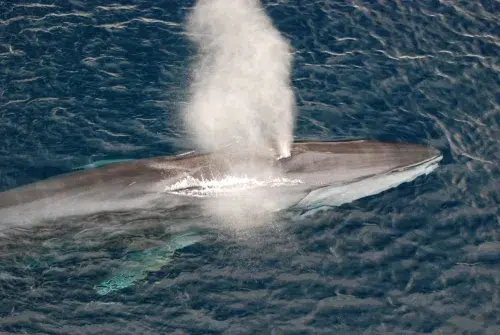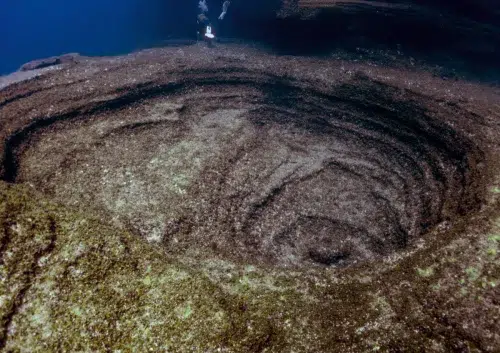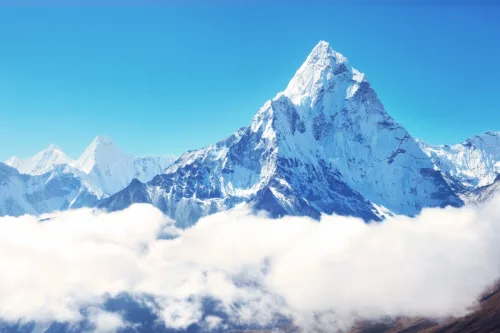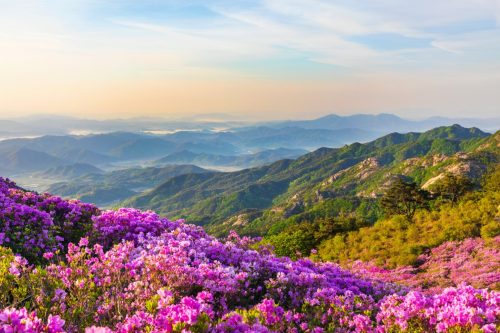Reading these tidbits, ranging from topics such as nature to global politics, will immediately enhance your intelligence.
There is an abundance of captivating and amusing facts in the world, with over 7.8 billion people, as well as various plants and animals, spread across nearly 200 countries. For instance, in New Zealand, you will discover the world’s highest concentration of pet owners, while Nicaragua is home to one of only two flags worldwide that includes the color purple. If you are hungry for more intriguing information about the Earth’s history, current state, and future, continue reading to expand your knowledge.
1. Approximately 69% of the Earth’s freshwater is contained in glaciers and ice sheets.

Water in Crisis: A Guide to the World’s Fresh Water Resources, a publication by the United States Geological Survey (USGS), reports that slightly more than 96% of the earth’s water is located in its oceans. However, this water is mostly saltwater. To locate the majority of the world’s freshwater, one must travel to the poles, where 68.7% of it is contained in ice caps, permanent snow, and glaciers.
2. The maximum recorded speed of a wind gust on Earth is 253 miles per hour, which is the fastest on record.

Hold onto your hats, as this is no ordinary wind storm. In 1996, a tropical cyclone called Olivia made landfall near Barrow Island, Australia, with such ferocity that it shattered an incredible record. As reported by The Weather Channel, “Olivia’s eyewall generated five extremely powerful three-second wind gusts, with the highest reaching a speed of 253 mph,” surpassing the previous wind record of 231 mph, set in Mount Washington, New Hampshire, in 1934.
3. he most severe droughts in Europe occurred within the past 2,100 years.

Since 2015, Europe has faced severe dry spells and heatwaves resulting in significant droughts. A recent study conducted by the University of Cambridge, published on the National Oceanic and Atmospheric Administration website, analyzed isotopes in the rings of ancient European Oak trees in Central Europe, formed over thousands of years, to determine the root cause. The study found that human-induced climate change and related changes in the jet stream were responsible for these dry spells, as reported by EurekAlert!.
4. Hawaii is the ultimate destination for experiencing the most spectacular rainbows in the world.

For those who love admiring rainbows and desire to experience the spectacular phenomenon to the fullest, Hawaii is the perfect destination. A 2021 research article from the American Meteorological Society observed that Hawaii’s terrain, with its mountains generating distinct variations in clouds and precipitation, plays a vital role in creating numerous and vivid rainbows. The presence of air pollution, pollen, and high waves adds to Hawaii’s distinction as a premier location for experiencing rainbows of superior quantity and quality.
5. Underneath 1.4 km of ice in Greenland lie fossilized plants.

Approximately 80% of Greenland’s surface is occupied by the Greenland Ice Sheet, identified by Britannica as the “largest and potentially solitary remains of the Pleistocene glaciations in the Northern Hemisphere.” Nevertheless, was it always covered in ice? In 1966, during the Cold War, researchers extracted a 1.4 km core sample at Camp Century and discovered “well-preserved fossil plants and biomolecules” at its base, indicating that the enormous ice sheet melted and reassembled at least once within the past million years. How chilly!
6. The vocalizations of whales have the potential to be utilized for mapping the topography of the seafloor.

According to Scientific American, male Fin whales produce the loudest songs of all marine life, which can be heard up to 1,000 kilometers (600 miles) away. These deep, bellowing songs are used to attract mates and are similar to Barry White’s music. The songs can also be used to create sonar maps of the ocean floor since the sound can reach depths of 2.5 kilometers (1.6 miles) underwater and bounce back, providing precise measurements for researchers. Recently, a study published in Science in 2021 demonstrated how utilizing the songs of Fin whales can be more beneficial and less damaging to marine life than using traditional research tools such as large air guns.
7. Deep-sea volcanoes have revealed the discovery of new creatures.

It may seem like a scenario ripped from a science fiction horror movie, but the discovery of new life forms in the depths of the ocean is a reality. In 2020, a study of a deep-sea volcano near New Zealand was published in the Proceedings of the National Academy of Sciences of the United States of America, revealing the existence of “over 90 putative bacterial and archaeal genomic families and nearly 300 previously unknown genera.” Hydrothermal vents, such as deep-sea volcanoes, have been associated with the “origin of life” in some studies. It remains to be seen whether these discoveries will offer insight into the emergence of future terrestrial life forms.
8. The current measurement of Mount Everest indicates that it is larger than the previous measurement.

Mount Everest may not have physically grown, having reached maturity a long time ago, however, the most recent measurement performed by surveyors representing China and Nepal has the mountain peak standing taller than we’d thought in the past. Previous readings have ranged from 29,002 feet above sea level in 1856 down to 20,029 in 1955, according to NPR. But after the long process of measuring the mountain with GPS devices, experts have now stated that Mount Everest stands at a whopping 29,031.69 feet, due to plate tectonics.
9. Flowers are changing their color due to the effects of climate change.

Rest assured that your beloved red roses won’t suddenly transform into turquoise overnight. However, the degradation of the ozone layer over the past decades has resulted in an uptick in UV radiation, causing a global phenomenon of flower coloration change. According to a study conducted by scientists from Clemson University in 2020, the UV pigmentation in flowers has risen over time, leading to a decline in the quality of their pollen. While this color change is invisible to the naked eye, it poses a significant challenge for pollinators such as bees, which rely on the vibrant hues of flowers for attraction.
10. Dentistry can be considered as one of the oldest professions in human history.

Although dentistry doesn’t date all the way back to the origins of humanity, there is evidence of teeth being drilled in skulls that date back 7,500 to 9,000 years ago, likely accomplished using a prehistoric bow-drill. This suggests that the concept of dentistry has been around for quite some time, possibly even as far back as the first human civilizations. Additionally, research conducted by the University of Bologna, Italy on a 14,000-year-old skull revealed that one rotten tooth had been intentionally treated with a tool, further demonstrating the early existence of dentistry. As a result, dentistry can be considered one of the oldest recorded professions, which is certainly something to smile about.
11. Coca-Cola is unavailable for purchase only in North Korea and Cuba.

It’s reassuring to know that Coca-Cola is available almost anywhere you go, except for a few places like North Korea or Cuba, where it hasn’t been officially introduced due to U.S. trade embargoes. Despite this, there are reports of people managing to get their hands on the drink if they put in the effort, though it would likely be pricier than in the U.S. and imported from nearby countries like Mexico or China. This information comes from the BBC.
12. Los Angeles has enough space to accommodate the entire population of the world.

It is a widely known fact that the global population has surpassed 7.5 billion individuals, which can be an overwhelming figure to comprehend. Nevertheless, it may seem less daunting once you realize that, as per National Geographic, all these people could occupy an area of 500 square miles, such as that of Los Angeles, if they stood side by side.
13. Never before have there been as many twins as there are now.

According to Alexis C. Madrigal of The Atlantic, twins are not as rare as one might assume, as their occurrence has been increasing steadily. In the early 1900s, approximately 2 percent of babies born were twins, but this rate has since risen. By 1995, the rate had climbed to 2.5 percent, and in 2010, it hit 3.3 percent, meaning that one out of every 30 babies born is a twin. This trend is believed to be influenced by the fact that older women tend to have more twins, as well as the fact that women are choosing to start families later. Fertility treatments, such as in-vitro fertilization, may also contribute to this increase.
14. The spiciest chili pepper on the planet is of such intensity that it has the potential to cause fatality.

The Dragon’s Breath chili pepper is extremely hot, earning it the label of “weapons-grade,” and has the potential to cause a severe form of anaphylactic shock that can lead to airway closure if ingested. The creator of this pepper, hobby grower Mike Smith, along with scientists from Nottingham University, developed it with the intention of using it as a numbing anesthetic for medical purposes. Despite having tried it himself and experiencing intense burning sensations, the impracticality of this chili was not a deterrent in its creation.
15. France receives more visitors than any other country.

With its exquisite wines, mouth-watering cheeses, and undeniable romantic charm, France boasts a remarkable beauty that draws in countless visitors each year. In fact, according to the United Nations World Tourism Organization, France is the most sought-after destination in the world. In 2017 alone, 86.9 million people flocked to this European gem, surpassing other popular countries like Spain, the United States, China, and Italy. Indeed, la vie est belle!
